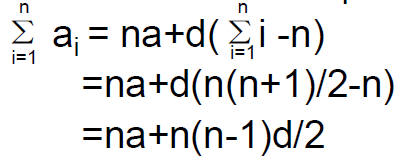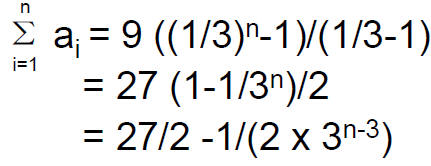Function Sequence and Summation
Function
• Suppose A and B are nonempty sets. A function from A to B is an assignment
of exactly one
element of B to each element of A.
– We write f: A→B.
– We write f(a)=b if b is the element of B assigned to element a of A.
• Example:
f: Z → Z
where for each x ∈ Z, f(x)=x^2.
Domain, codomain, range
• Suppose f is a function from A to B.
– We say A is the domain of f.
– We say B is the codomain of f.
– We say {f(x) | x ∈ A } is the range of f.
• Example:
f: Z → Z
where for each x ∈ Z, f(x)=x^2.
• Domain of f: Z
• Codomain of f: Z
• Range of f: {x|x=y^2, y ∈ Z}
Image and preimage
• Suppose f is a function from A to B and f(x)=y.
– We say y is the image of x.
– We say x is an preimage of y .
– Note that the image of x is unique but there can be more than one
preimages for y.
• Example:
f: Z → Z
where for each x ∈ Z, f(x)=x^2.
• Image of 2: 4
• Preimage of 4: 2
• Another preimage of 4: -2
• Note that every element in the domain has an image.
– But not every element in the codomain has a preimage. Only those in the
range have preimages.
• Example:
f: Z → Z
where for each x ∈ Z, f(x)=x^2.
• Each x ∈ Z has an image f(x)=x^2 .
• But negative integers in Z do not have preimages.
• Only perfect squares (i.e., those in the range) have preimages.
One-to-one function
• A function is one-to-one if each element in
the range has a unique preimage.
– Formally, f: A→B is one-to-one if f(x)=f(y)
implies x=y for all x ∈A,y ∈A.
• Example:
f: Z → Z
where for each x ∈ Z, f(x)=x^2.
• Clearly, f is NOT one-to-one because 4 has two preimages
Example one-to-one function
• f: N → Z
where for each x ∈ N, f(x)=x+5.
• f: Z+ → Z+
where for each x ∈ Z+, f(x)=x^2.
• f:{0,1,2} →{0,1,2,3}
where f(0)=1, f(1)=3, f(2)=2.
Onto function
• A function is onto if each element in
codomain has an image (i.e., codomain = range).
– Formally, f: A→B is onto if for all y ∈B, there is
x ∈A such that f(x)=y.
• Example:
f: Z → Z
where for each x ∈ Z, f(x)=x^2.
• Clearly, f is NOT onto because 2 does not have any preimage.
Example onto function
• f: R → {0} ∪ R+
where for each x ∈ R, f(x)=x^2.
• f: N → Z+
where for each x ∈ N, f(x)=x+1.
• f:{0,1,2,3} →{0,1,2}
where f(0)=1, f(1)=1, f(2)=2, f(3)=0.
Sum of functions
• Suppose f1, f2, …, fn are functions from A to R. The sum of f1, f2, …, fn
is also a
function from A to R defined as follows:
(f1+ f2+…+ fn )(x)= f1(x)+ f2(x) +…+ fn (x).
• Example:
f, g: R → R
where for each x ∈ R, f(x)=x+5; g(x)= x-3.
• Then, f+g is defined as (f+g) (x)= 2x+2.
Product of functions
• Suppose f1, f2, …, fn are functions from A to R. The product of
f1, f2, …,
fn is also a
function from A to R defined as follows:
(f1 f2 … fn )(x)= f1(x) f2(x) … fn (x).
• Example:
f, g: R → R
where for each x ∈ R, f(x)=x+5; g(x)= x-3.
• Then, f+g is defined as (f g) (x)= x^2+2x-15.
Bijection
• A function is a bijection if it is both one-to-one and onto.
• Example:
– Consider f: Z+ → Z+ where for each x ∈ Z +, f(x)=x^2. This is NOT a
bijection because it is not onto.
– Consider f: R → {0} ∪ R+ where for
each x ∈ R, f(x)=x^2. This is NOT a bijection either, because it is not
one-to-one.
– Consider f: R+ → R+ where for each x ∈ R+
, f(x)=x^2. This is a bijection.
Inverse function
• Suppose f is a bijection from A to B. The inverse function of f is the
function from B to A that assigns element b of B to element a of A if and only
if f(a)=b.
– We use f-1 to represent the inverse of f.
– Hence, f-1(b)=a if and only if f(a)=b.
• Example:
Consider f: R + → R+ where for each x ∈ R+ , f(x)=x^2. Its
inverse function is g: R + → R+ where for each x ∈ R+ ,
g(x)= sqrt (x).
Example inverse function
• Consider f: R + → R+ where for each x ∈ R+ , f(x)=4x+3. What is f-1 ?
• Consider f: {0,1,2} → {0,1,2} where f(0)=1, f(1)=2, f(2)=0. What is f-1 ?
Function composition
• Suppose g is a function from A to B, and f is a function from B to C. Then
the composition of f and g is defined as:
(f o g) (x)= f(g(x)).
• Example: Consider f: R → R where for each x ∈ R , f(x)=2x+3, and g: R →
R where for each x ∈ R , g(x)=3x-2.
Then, (f o g) (x)= f(3x-2) = 2(3x-2)+3=6x-1
Example composition
• Consider f: {0,1,2} →{0,1,2} where f(0)=1, f(1)=2, f(2)=0; also consider g:
{0,1,2} →{1,2,3}
where f(0)=1, f(1)=2, f(2)=3.What is g o f ?
Incommutability of composition
• Consider f: R → R where f(x)=x+1, and g: R → R where g(x)=x^2.
– It is not hard to get that f o g (x) = x^2 +1.
– Similarly, we have that g o f (x) = (x +1)^2.
– Clearly, f o g ≠ g o f
• In general, function composition is incommutable, which means the order of arguments in composition is important.
Graph of function
• We can often draw a graph for a function f: A → B : For each x
∈ A, We draw
a point (x, f(x)).
– Typically, we need A and B to be subsets of R.
• The graph of some important functions:
– Linear function f(x)= kx+b : line
– Constant function f(x) = c: line parallel to the X-axis
– Quadratic function f(x) = ax^2+bx+c: parabola
Sequence
• A sequence is a function whose domain is a set
of integers.
– The domain is typically Z+ (or, sometimes, N).
– The image of n is an.
– Each image an is called a term.
– For convenience, we often write it as a1, a2, …, or {an}.
• Example:
1, 4, 9, 16, 25,… is a sequence, where the nth term is a n =n^2 .
Example sequence
• 2, 9, 28, 65, … where the nth term is an =n^3 +1.
• 0, -2, -6, -12, … where the nth term is an = -(n-1)(n-2).
• 0, 1/2, 2/3, 3/4, … where the nth term is an = 1-1/n.
• -1, 1, -1, 1, … where the nth term is an = (-1)n.
Arithmetic sequence
• An arithmetic sequence is a sequence of the form a, a+d, a+2d, …
– Formally, it is a sequence {an}, where an =a+(n-1)d .
– Here a is called the initial term.
– Here d is called the common difference .
• Example: 9, 4, -1, -6, … is an arithmetic sequence, because it is of the form
an = 9 -5(n- 1). The initial term is 9, and the common difference is -5.
Example arithmetic sequence
• Let x and y be two real numbers . Consider a sequence {an}, where
an = 5xn
+3y . Is this an arithmetic sequence?
– The answer is yes, because we can rewrite it as an =(5x+3y)+5x(n-1).
– The initial term is 5x+3y.
– The common difference is 5x.
Geometric sequence
• A geometric sequence is a sequence of the form a, ar, ar2, …
– Formally, it is a sequence {an}, where an =arn-1 .
– Here a is called the initial term.
– Here r is called the common ratio.
• Example: 9, 3, 1, 1/3, … is an geometric
sequence, because it is of the form an= 9 (1/3)n-1.
The initial term is 9, and the common ratio is 1/3.
Example geometric sequence
• Let x≠1 be a real number . Consider a
sequence {an}, where an =x2n+5 . Is this a
geometric sequence?
– The answer is yes, because we can rewrite it
as an =x^7 x^2n-2 = x^7 (x^2)n-1 .
– The initial term is x^7.
– The common ratio is x^2.
Sum of terms
• Given a sequence {an}, we can sum up its mth through nth terms. We write this sum as

– Note it is just a simplified way to write am+am+1+…an . There is no
difference in meaning.
– Here i is called the index of summation, m is called the lower limit of the
index, and n is called the upper limit.
Sum of arithmetic sequence
• We are often interested in the sum of first n terms of a sequence. For example, consider an arithmetic sequence {an},
where an =a+(n-1)d . We have

– So the main problem is to find
• What is
– Let us denote it by S.
–Recall its definition: S=1+2+…+n .
–We can change order of terms : S= n+…+2+1.
– Adding up the above two equations , we get 2S=(n+1)+(n+1)+…+(n+1)=n(n+1)
–We get S=n(n+1)/2
• Now we come back to the sum of first n terms of arithmetic sequence:

• The above is the important formula for the sum of arithmetic sequence. You should memorize it.
Example sum of arithmetic sequence
• Consider the arithmetic sequence 9, 4, -1, -6, … The sum of first n terms is

• Thus the sum of first 10 terms is

Sum of geometric sequence
• Now consider an geometric sequence {an}, where an =arn-1 . We have

– So the main problem is to find

• What is
– Let us denote it by S.
– Recall its definition: S=1+R+…+rn-1 .
– We multiply both sides by r: rS= R+…+rn-1+rn.
– Taking the difference of two equations , we get (r-1)S=rn-1
– Assuming r≠1, we get S=(rn-1)/(r-1) .
• Now we come back to the sum of first n terms of geometric sequence:

• The above is the important formula for the sum of arithmetic sequence. You should memorize it.
• Bear in mind that this formula assumes r≠1.
(Question: what is the formula for r=1 ?)
Example sum of geometric sequence
• Consider the geometric sequence 9, 3, 1, 1/3, ... The sum of first n terms is

• Thus the sum of the first 5 terms is

Homework 5
• Due in class Oct 21, Tuesday
• Rosen 2.3: Questions 10, 14, 18, 58, 60.
• Rosen 2.4: Questions 2, 4, 14, 16, 18.
• Optional Question (Extra Credit of 10 points):
Consider a sequence {an}. Denote by Sn the sum
of first n terms of this sequence. Suppose that,
for all integer n≥2, we have that an+2SnSn-1=0.
Also suppose that a1=1/2.
(1) Prove that {1/Sn} is an arithmetic sequence.
(2) What is an ? Justify your answer
| Prev | Next |